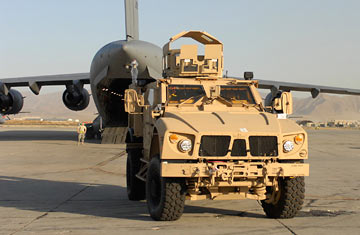
Mine-Resistant Ambush Protected (MRAP) vehicle M-ATV
October has been a haunted month for U.S. troops in Afghanistan. On Tuesday, it became the deadliest month of the eight-year war when the death of eight more U.S. troops took the month's death toll to 53. But the military is hoping that the deployment, since October, of the first lighter and more agile Mine-Resistant Ambush-Protected All-Terrain Vehicles (M-ATVs) on Afghan soil can help reduce the casualty count. Yet, as the Taliban develops increasingly deadly weapons — with Iran's help, according to U.S. intelligence — the U.S. is changing over to vehicles lighter than those it used in Iraq.
Unlike Iraq, with its broad and flat highways, Afghanistan has relatively few roads, many of which pass through narrow mountain passes and over relatively weak bridges. "It can be pretty tough to maneuver," Admiral Mike Mullen, chairman of the Joint Chiefs of Staff, told troops in South Korea last week. "I've talked to troops that have gotten stuck in places that they didn't expect to get stuck in."
That why the Pentagon has ordered more than 5,000 of the M-ATVs (called "baby MRAPs" by some) for its Afghanistan forces. These vehicles and their V-shaped hulls are designed to deflect the blasts of roadside bombs, which have become the Taliban's weapon of choice. Such improvised explosive devices killed only a single U.S. soldier in 2003 but have killed more than 100 so far this year, accounting for nearly half of the U.S. deaths.
The eight U.S. troops killed Tuesday had been aboard 20-ton Stryker vehicles that hit IEDs. That's about the same weight as many MRAPs in Iraq, and several tons heavier than those now being delivered to Afghanistan (various classes of each vehicle make weight comparisons tricky). The MRAP program, championed by Defense Secretary Robert Gates, has won praise from soldiers for the protection the vehicles offer them from roadside bombs. There are some 12,000 MRAPs in Iraq, and 3,600 of the original MRAPs in Afghanistan, up from almost none last year. The U.S. has spent nearly $30 billion on some 20,000 MRAPs, including $1.4 million each for the M-ATVs earmarked for Afghanistan.
The M-ATVs are being built in Wisconsin by Oshkosh Defense. Capable of carrying five soldiers (the original MRAPs carry between seven and 13), they're sent to South Carolina, where they're outfitted with communications and other government-supplied gear, before U.S. Air Force cargo planes deliver them on daily flights to Afghanistan. Eventually, they'll go more slowly, and cheaply, by sea. "We'll have them there no later than March," Mullen said of the 5,000 M-ATVs. "We recognize that is the principal threat."
But as usual in war, the enemy gets a vote. Just as these new, lighter MRAPs are reaching U.S. troops in Afghanistan, evidence continues to mount that Iran — which helped Iraqi insurgents develop particularly lethal explosively formed penetrator (EFP) IEDs — may be doing the same thing in Afghanistan. Dennis Blair, the director of national intelligence, told the Senate Intelligence Committee earlier this year that "Iran has both long-term strategic and short-term tactical interests in Afghanistan and is not content with merely maintaining the status quo." Its desire to undermine "Western influence in Afghanistan" had led it to provide "select Afghan insurgents with lethal aid," he said.
In June, Gates charged that Tehran was playing a "double game" in Afghanistan, seeking good relations with Kabul while funneling arms to insurgents. "They profess to have warm relations with the Afghan government," Gates said. "At the same time, they're sending in a relatively modest level of weapons and capabilities to attack ... coalition forces." In August, Afghan forces discovered a cache of weapons — including EFPs — in the western part of the country that shares a border with Iran.
So U.S. officials are watching Tehran closely. "Iran's current policies and actions do not pose a short-term threat to the mission," General Stan McChrystal, the top U.S. commander in Afghanistan, warned in his leaked August assessment. "But Iran has the capability to threaten the mission in the future."
